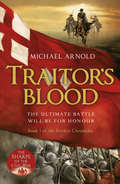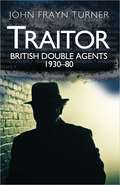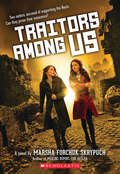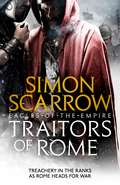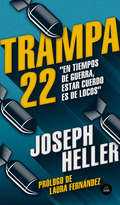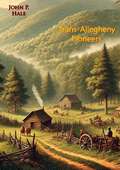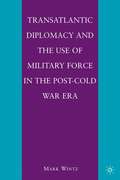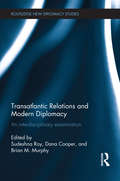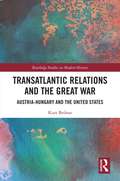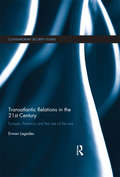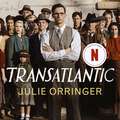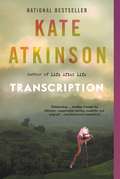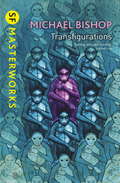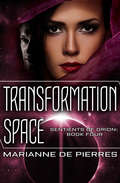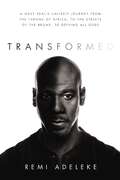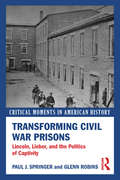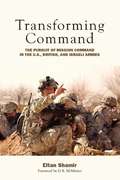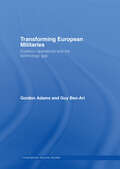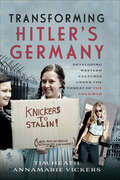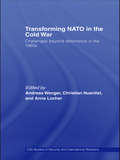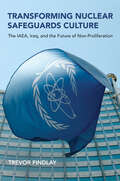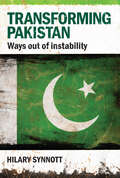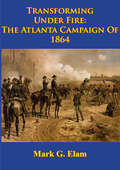- Table View
- List View
Traitor's Blood: Book 1 of The Civil War Chronicles (Stryker)
by Michael ArnoldTraitor's Blood, the first in The Civil War Chronicles, Michael Arnold's acclaimed series of historical thrillers, sees battle-scarred hero Captain Stryker, 'the Sharpe of the Civil War', confront his nemesis. 'Stands in comparison with the best of Cornwell' Yorkshire PostOnce seen in the heat of battle, Captain Stryker is never forgotten. A hardened veteran of the wars in the Low Countries, he has come home to England to seek revenge on the man who left him for dead and scarred him for life.Stryker is driven by loyalty rather than conviction to serve King Charles's cause. He has no truck with aristocracy, preferring the company of a handful of trusted men, including sometime actor Lancelot Forreseter and his foul-mouthed sergeant, Skellen. But when the existence of a dangerous spy at the heart of the Royalist establishment is discovered, it is Stryker whom Prince Rupert chooses to capture the man before he realises the game is up.Lightly armed and with only a handful of men, Stryker must journey across a country riven by bitterness and beset by marauding bands of soldiers in a race against time. But unbeknown to Stryker, someone else is also closing in on his quarry, someone whom Stryker has sworn to kill: Captain Eli Makepeace, his nemesis, the man who nearly destroyed him . . .
Traitor: British Double Agents 1930-80
by John TurnerFollowing the success of 'Tinker, Tailor, Soldier, Spy' and increased 'spy fever', this 'Traitor: British Double Agents' covers in detail all the spies known to have acted against Britain from the 1930s to the 1980s. John Frayn Turner reveals the infamous Cambridge spy network, made up of well-knwon names including Burgess, Maclean, Philby and Blunt, studies the Microdots Case in detail, lists the atomic secret spies, analyses the downfall of master spy Blake and his subsequent escape while serving a 42-year sentence and details others who sold Britain's secrets.
Traitors Among Us
by Marsha Forchuk SkrypuchWorld War II may be over. But two sisters are far from safe.Inspired by true events, this is the latest gripping and powerful novel from the acclaimed author of Making Bombs for Hitler.Sisters Krystia and Maria have been through the worst -- or so they think. World War II ravaged their native Ukraine, but they both survived, and are now reunited in a displaced persons camp.Then another girl accuses the sisters of being Hitler Girls -- people who collaborated with the Nazis. Nothing could be further from the truth; during the horrors of the war, both sisters resisted the Nazis and everything they stood for. But the Soviets, who are now in charge, don't listen to the sisters' protests. Krystia and Maria are taken away and interrogated for crimes they never committed.Caught in a dangerous trap, the sisters must look to each other for strength and perseverance. Can they convince their captors that they're innocent -- or escape to safety before it's too late?
Traitors of Rome (Eagles of the Empire 18): Roman army heroes Cato and Macro face treachery in the ranks
by Simon ScarrowTRAITORS OF ROME: THE SUNDAY TIMES BESTSELLERAn enthralling Cato and Macro adventure from bestselling author Simon Scarrow. Not to be missed by readers of Conn Iggulden and Bernard Cornwell. AD 56. Battle-hardened veterans of the Roman army Tribune Cato and Centurion Macro are garrisoned at the eastern border, aware that their movements are constantly monitored by spies from dangerous, mysterious Parthia. But the enemy within could be the deadliest threat to the Legion ... and the Empire. There's a traitor in the ranks. Rome shows no mercy to those who betray their comrades, and the Empire. But first the guilty man must be discovered. Cato and Macro are in a race against time to expose the truth, while the powerful enemy over the border waits to exploit any weaknesses in the Legion. The traitor must die ... Praise for Simon Scarrow's bestselling novels: 'Blood, gore, political intrigue...A historical fiction thriller that'll have you reaching for your gladius' Daily Sport'Gripping... ferocious and compelling' Daily Express'Brilliantly told adventures ... Roman soldiering at its very best - even by Scarrow's high standards' Sunday Sport
Traitors of Rome: Roman army heroes Cato and Macro face treachery in the ranks (Eagles Of The Empire Ser.)
by Simon ScarrowTRAITORS OF ROME: THE SUNDAY TIMES BESTSELLERAn enthralling Cato and Macro adventure from bestselling author Simon Scarrow. Not to be missed by readers of Conn Iggulden and Bernard Cornwell. AD 56. Battle-hardened veterans of the Roman army Tribune Cato and Centurion Macro are garrisoned at the eastern border, aware that their movements are constantly monitored by spies from dangerous, mysterious Parthia. But the enemy within could be the deadliest threat to the Legion ... and the Empire. There's a traitor in the ranks. Rome shows no mercy to those who betray their comrades, and the Empire. But first the guilty man must be discovered. Cato and Macro are in a race against time to expose the truth, while the powerful enemy over the border waits to exploit any weaknesses in the Legion. The traitor must die ... Praise for Simon Scarrow's bestselling novels: 'Blood, gore, political intrigue...A historical fiction thriller that'll have you reaching for your gladius' Daily Sport'Gripping... ferocious and compelling' Daily Express'Brilliantly told adventures ... Roman soldiering at its very best - even by Scarrow's high standards' Sunday Sport
Trampa 22 (Bolsillo Ser.)
by Joseph HellerUn clásico moderno absolutamente rompedor sobre el sinsentido de la guerra en una nueva edición con prólogo de Laura Fernández. Trampa-22 es uno de los mejores libros del siglo xx y ha sido recientemente adaptado como miniserie televisiva protagonizada por George Clooney y Christopher Abott. Durante la Segunda Guerra Mundial, en el hospital de la base norteamericana de una minúscula isla italiana, un piloto de bombardero llamado Yossarian finge estar loco. Quiere evitar a toda costa perder la vida en su próxima misión aérea y regresar a casa. ¿Por qué demonios intentan todos matarle desde abajo?, se pregunta cada vez que lanza una bomba. Yossarian intenta demostrar que está loco pero cae en la «trampa 22»: una absurda y perversa regla militar que afirma que aquellos que alegan locura para no ir a la guerra son los más cuerdos. Y si estás cuerdo, estás sano, así que... ¡no te queda otra! Publicada originalmente en 1961, Trampa 22 es sin lugar a dudas una de las obras maestras más divertidas y celebradas de todos los tiempos y una piedra angular de la tradición literaria norteamericana, que le ha valido estar en las listas de los mejores libros del siglo xx. El lector se sumergirá en una ráfaga de situaciones absurdas y diálogos delirantes que subrayan la estupidez de la guerra y del ser humano. Y es que «el infierno somos, y hemos sido siempre, nosotros», apunta Laura Fernández en el prólogo. «Si iba a describir un infierno, sería uno rabiosamente divertido. Porque así de ridículo es el mundo. [...] para que esta humanidad trate de aprender algo de sí misma.» Críticas:«No hay ningún libro como este [...] sorprendentemente poderoso.»Norman Mailer, Esquire «Trampa 22 es la única novela bélica que he leído que tiene sentido.»Harper Lee «Novela bomba [...]. Heller no solo descubrió "el lado gracioso" de la Segunda Guerra Mundial, sino que, además, anticipó las horriblemente hilarantes alucinaciones de Vietnam abriendo paso y escotillas para soltar absurdistas y entrópicos como Vonnegut, Berger, Kesey, Barthelme, Brautigan, Pynchon, Elkin, Friedman y Hunter Thompson y, más cerca, Wallace, Saunders y Palahniuk.»Rodrigo Fresán, Babelia, El País «Una de las obras más terriblemente divertidas en el uso del lenguaje [...]. Explosiva, implacable, subversiva, brillante.»Robert Brustein, The New Republic «Trampa 22 es una novela que nos recuerda una vez más todo aquello que hemos dado por supuesto en nuestro mundo y que no deberíamos, la locura que intentamos que pase desapercibida, las decepciones y las mentiras que no tenemos la voluntad de discernir de la verdad.»John W. Adridge, The New York Times Review «A mi parecer, en los últimos cincuenta años ha habido dos grandes novelas norteamericanas. Trampa 22 es una de ellas.»Stephen King, Entertainment Weekly «Esta no es meramente la mejor novela norteamericana que surgió de la Segunda Guerra Mundial, es la mejor novela norteamericana que ha surgido en años de cualquier lugar.»Nelson Algren, The Nation «Lo que tienen en las manos [...] es un monumento [...] hecho de páginas y personajes [...] suculentamente delirantes.»Laura Fernández
Trans-Allegheny Pioneers: Hardships and Heroism
by John P. HaleJohn P. Hale’s "Trans-Allegheny Pioneers" offers an enthralling chronicle of the early settlers who ventured west of the Virginian Alleghenies, forging a path into the uncharted wilderness from 1748 onwards. This meticulously researched history provides an intimate look at the hardships, heroism, and indomitable spirit of those who dared to pioneer the frontier.Hale’s narrative captures the essence of early American frontier life, detailing the struggles and triumphs of the first white settlers as they established communities in the rugged and often hostile terrain beyond the Alleghenies. Through vivid storytelling and rich historical detail, Hale brings to life the experiences of these brave men and women, whose resilience and determination laid the foundations for future generations.The book delves into the myriad challenges faced by the pioneers, from skirmishes with Native American tribes to the relentless forces of nature. Hale paints a vivid picture of the relentless courage required to survive and thrive in such an unforgiving environment. He also highlights the crucial moments of cooperation, ingenuity, and solidarity that defined these early settlements."Trans-Allegheny Pioneers" is not just a historical account; it is a tribute to the spirit of exploration and the enduring human desire to seek new horizons. Hale’s engaging prose and thorough research provide readers with a nuanced understanding of the complex dynamics at play during this formative period in American history. His work sheds light on the cultural exchanges, conflicts, and alliances that shaped the frontier.Through detailed biographies, personal anecdotes, and historical context, Hale honors the legacy of the pioneers whose bravery and perseverance paved the way for the expansion of the American frontier. "Trans-Allegheny Pioneers" is an invaluable resource for historians, genealogists, and anyone interested in the rich tapestry of America’s early settlement history.Join John P. Hale on a journey through time, exploring the remarkable stories of hardship and heroism that defined the first white settlements west of the Virginian Alleghenies. This compelling narrative celebrates the pioneering spirit that continues to inspire and resonate today.
Transatlantic Diplomacy and the Use of Military Force in the Post–Cold War Era
by Mark WintzThis book is an analysis and a set of tools of analysis to explain and understand why, when, where, and how the United States and its major NATO allies will agree or disagree on a collective policy regarding using military force abroad.
Transatlantic Relations and Modern Diplomacy: An interdisciplinary examination (Routledge New Diplomacy Studies)
by Dana Cooper Sudeshna Roy Brian M. MurphyThis book explores the transatlantic relationship between the US and Europe from multiple perspectives and disciplines. Since the end of the Cold War, a multi-polar world has replaced the dual power economic and political stranglehold previously shared by the US and Russia. Amid the shift in power politics, the transatlantic partnership between the US and Europe has retained its importance in shaping the outcome of future global developments. With the rise of the US as a major world power and the tremendous economic growths witnessed by countries such as China, India and Brazil, the political power structures within and outside the transatlantic relations have gradually undergone shifts that are important to recognise, understand and critically assess on a consistent basis. Transatlantic Relations and Modern Diplomacy assesses the strengths and weaknesses of this enduring transatlantic relationship from multiple perspectives and disciplines at a time when the US and European countries are facing increasing economic pressures, significant political changes and substantial security concerns. Examining this relationship through a range of different lenses including historical, economic and cultural, this book highlights the importance of examining the transatlantic relationship from a variety of different contextual and historical perspectives in order to herald the future changes as informed global citizens. This book will be of interest to students of transatlantic studies, diplomacy, political science and IR in general.
Transatlantic Relations and the Great War: Austria-Hungary and the United States (Routledge Studies in Modern History)
by Kurt BednarTransatlantic Relations and the Great War explores the relations between the Danube Monarchy of Austria-Hungary and the modern US democracy and how that relationship developed over decades until it ended in a final rupture. As the First World War drew to a close in late 1918, the Mid-European Union was created to fill the vacuum in Central and Eastern Europe as the old Danube Monarchy of Austria-Hungary was falling apart. One year before, in December 1917, the United States had declared war on Austria-Hungary and, overnight, huge masses of immigrants from the Habsburg Empire became enemy aliens in the US. Offering a major deviation from traditional historiography, this book explains how the countdown of mostly diplomatic events in that fatal year 1918 could have taken an alternative course. In addition to providing a narrative account of Austrian-Hungarian relations with the US in the years leading up to the First World War, the author also demonstrates how an almost total ignorance of the affairs of the Dual Monarchy was to be found in the US and vice versa. This book is a fascinating and important resource for students and scholars interested in modern European and US history, diplomatic relations, and war studies.
Transatlantic Relations in the 21st Century: Europe, America and the Rise of the Rest (Contemporary Security Studies)
by Erwan LagadecThis book offers an overview of the interface between European integration, transatlantic relations, and the 'rise of the rest' in the early 21st century. The collapse of the Soviet bloc opened up an era in which the drivers and perceived benefits of the US alliance among European countries have become more variegated and shifting. The proposition that the US remains at once an 'indispensable' and 'intolerable' nation in Europe is a key concept in the alliance, as the US remains inextricably tied to the continent through economic, military and cultural links. This work examines this complex subject area from many angles, including an analysis of the historical and cultural contexts of America’s relations with Europe, as well as a discussion of the politics of transatlantic affairs which utilises evidence gleaned from a series of case-studies. In the concluding chapters, the author assesses the likelihood that the West can entrench its global dominance in the realms of "soft" and "hard" power, and by effecting a "controlled reform" that will see multilateral structures open up to emerging powers. This book will be of great interest to students of European Politics, EU integration, transatlantic relations, US foreign policy/diplomacy, International Security and IR in general.
Transatlantic: Based on a true story, utterly gripping and heartbreaking World War 2 historical fiction
by Julie OrringerSoon to be a major Netflix series1940, France. In the middle of a devastating war, how many lives can you save?Varian Fry, a young American journalist, arrives in Marseille armed only with three thousand dollars and a list of writers, thinkers and artists he hopes to rescue - so long as the Nazis don't get to them first.With borders closing around him, Varian tries to track down those on his list; renowned artists like Marc Chagall, who cannot believe that he will ever be unsafe in the country he loves. He smuggles them over the Pyrenees mountains and across the sea hidden in boats, but every day hundreds of ordinary Jewish refugees beg him for help. Does Varian have the right to choose who to save?At home in New York, making a list seemed hard, but in the middle of humanity's darkest hour, Varian must do all he can to help. And as the Nazis begin to get word of Varian's secret operation, he must dig deep and find the courage to rescue as many innocents as he can.Even though his own life may be in terrible danger.An incredibly compelling and heart-wrenching historical novel, inspired by a powerful true story, about the extraordinary courage and friendships forged during humanity's darkest hour. If you loved Schindler's List, All the Light We Cannot See or The Tattooist of Auschwitz, you'll adore Transatlantic, previously published as The Flight Portfolio.(P) 2019 Recorded Books
Transcription: A Novel
by Kate Atkinson<P> In 1940, eighteen-year old Juliet Armstrong is reluctantly recruited into the world of espionage. Sent to an obscure department of MI5 tasked with monitoring the comings and goings of British Fascist sympathizers, she discovers the work to be by turns both tedious and terrifying. But after the war has ended, she presumes the events of those years have been relegated to the past forever. <P><P>Ten years later, now a radio producer at the BBC, Juliet is unexpectedly confronted by figures from her past. A different war is being fought now, on a different battleground, but Juliet finds herself once more under threat. A bill of reckoning is due, and she finally begins to realize that there is no action without consequence. <P><P>Transcription is a work of rare depth and texture, a bravura modern novel of extraordinary power, wit and empathy. It is a triumphant work of fiction from one of the best writers of our time. <P><b>A New York Times Bestseller</b>
Transfigurations (S.F. MASTERWORKS)
by Michael BishopIn a clearing of the great forest of the planet Bosk Veld, a strange, ape-like species of alien, the Asadi, act out their almost-incomprehensible rituals, rainbow eyes flashing, spinning like pinwheels. Egon Chaney, in his anthropological study, "Death and Designation Among the Asadi" has shown how their life-style has apparently degenerated from a level of complex technological sophistication and devolved to a primal simplicity. Long after his disappearance in the forest, his daughter, Elegy Cather, comes to Bosk Veld to carry on his studies of the Asadi where he left off. With her is an intelligent ape, Kretzoi, physically adapted to resemble the aliens. Together with Thomas Benedict, Chaney's old partner, Elegy begins to unravel the enigma of the Asadi. As Kretzoi insinuates himself into their rituals, so we are drawn into what is perhaps the most convincing portrayal of the alien yet.
Transformation Space: Book Four Of The Sentients Of Orion (Sentients of Orion #4)
by Marianne de PierresWinner of the Aurealis Award for Best Science Fiction novel—the fourth Sentients of Orion book. &“Beautifully written . . . a serious series for a new generation&” (Falcata Times). Mira Fedor and her friends stand in the eye of the hurricane, and everything in the Orion League remains in flux. Mira is pregnant, and her gestation is proceeding at an inhuman pace. As she hides out on her bioship, Insignia, it seems clear that the extropist&’s procedures have had unforeseen effects—but will her child be more than human? As secrets are revealed and conspiracies exposed about the attack on Araldis, Mira wonders if there is still time to thwart one last master plan. The pieces are all in place; all that remains is for each side to commit to its endgame. But there is one question nobody has thought to ask: Will the Sole Entity—God—play by the rules? It is the epic conclusion to what the Sydney Morning Herald called &“Space opera supreme.&” Marianne de Pierres&’s epic series the Sentients of Orion has been called &“a grand space opera&” (Times Literary Supplement) and &“brilliant in all senses of the word&” (Sean Williams). All four books were short-listed for the prestigious Aurealis Award, with the final book winning for Best Novel. Don&’t miss the entire Sentients of Orion series: Dark Space, Chaos Space, Mirror Space, and Transformation Space.
Transformed: A Navy SEAL’s Unlikely Journey from the Throne of Africa, to the Streets of the Bronx, to Defying All Odds
by Remi AdelekeWhat are the odds? Statistics tell us that African American males who grow up in a single-parent household are nine times more likely to drop out of high school and twenty times more likely to end up in prison than any other demographic. But what would it take for one young man not only to rise above those statistics but also become a Navy SEAL, actor, entrepreneur, writer, and successful husband and father?In Transformed, Remi Adeleke takes you back to stories from his childhood, from living as Nigerian royalty to losing his father early in life and being stripped financially of everything by the Nigerian government. He delves into being raised by a single mother in the Bronx and doesn’t shy away from his illegal activities as a young man that threatened to derail his future. At every turn, including throughout his naval career, Adeleke found a way to overcome the odds, even when it didn’t make sense. His is an inspiring story of true personal transformation.
Transforming Civil War Prisons: Lincoln, Lieber, and the Politics of Captivity (Critical Moments in American History)
by Glenn Robins Paul J. SpringerDuring the Civil War, 410,000 people were held as prisoners of war on both sides. With resources strained by the unprecedented number of prisoners, conditions in overcrowded prison camps were dismal, and the death toll across Confederate and Union prisons reached 56,000 by the end of the war. In an attempt to improve prison conditions, President Lincoln issued General Orders 100, which would become the basis for future attempts to define the rights of prisoners, including the Geneva conventions. Meanwhile, stories of horrific prison experiences fueled political agendas on both sides, and would define the memory of the war, as each region worked aggressively to defend its prison record and to honor its own POWs. Robins and Springer examine the experience, culture, and politics of captivity, including war crimes, disease, and the use of former prison sites as locations of historical memory. Transforming Civil War Prisons introduces students to an underappreciated yet crucial aspect of waging war and shows how the legacy of Civil War prisons remains with us today.
Transforming Command: The Pursuit of Mission Command in the U. S., British, and Israeli Armies
by Eitan ShamirShamir (Dado Center for Interdisciplinary Military Studies, Israeli Defense Forces, and security studies, Tel Aviv U., Israel) examines the experiences of the armed forces in the US, Israel, and Britain in adopting, adapting, and implementing mission command since the 1980s and the factors involved in their success or failure. He begins by discussing the theory and history of mission command and the traditions of these countries before they adopted it from the Prussian-Germany Army, then the factors involved in adoption, such as changes in warfare, education, training, and personnel policies; how mission command was adopted in theory and practice; similarities in uses; and recent operations and organizational practices. Annotation ©2011 Book News, Inc., Portland, OR (booknews.com)
Transforming European Militaries: Coalition Operations and the Technology Gap (Contemporary Security Studies)
by Gordon Adams Guy Ben-AriA unique look at European Network Enabled Capabilities (NEC) and their implications for transatlantic co-operation in future operations. Gordon Adams and Guy Ben-Ari identify the key requirements for improvement of Europe’s abilities as an international actor. They focus on national and collaborative, as well as existing and planned, networks. They clearly show the reader how, with the removal of the risks of Soviet invasion, European defence planners must now modify their strategies and capabilities to address new threats, both at home and overseas. They also show why future operations within international coalitions will require network-based capabilities that can interoperate. Europe possesses a technological and industrial base adequate to supply such capabilities, and its defence strategies are gradually being modified to emphasize expeditionary forces operations within coalition settings. However, much remains to be done. This volume tackles the key challenges facing European nations who need to operate alongside each other and with their North American allies more effectively and efficiently. This book will be of great interest to all students of European affairs and politics, international relations and military and strategic studies.
Transforming Hitler's Germany: Developing Western Cultures under the Threat of the Cold War
by Tim Heath Annamarie VickersAs the last flames of the Second World War flickered and died, Germany emerged into an apocalyptic wasteland, where the Hitler Youth generation would be cursed with the running sore of National Socialism. With the uncaged bear of the Soviet Union flexing its muscles and the escalating tensions between East and West providing some distraction from the funeral pyre of the Third Reich, those living in West Germany soon understood that they were the geological bulkhead, a component in the prevention of communism spreading throughout the infantile peace of post-Second World War Europe. Despite all the destruction and political tensions which surrounded them, the young men and women of Germany were keen to experience the world beyond their own precarious borders. In August 1945, Tia Schuster and Lisa Kraus were two fourteen-year-old Berliners, and - like many - they found themselves shoehorned into what was to be the second ‘new era’ of their young lives. The first had brought about only death and destruction, yet this second had a cold unfamiliarity about it. As the late 1940s gave way to the 1950s and ‘60s, a series of new decadent eras - of rock-n-roll, fashion, flower power and sexual revolution - was on the horizon, which posed a threat to the traditional German way of life championed by the Nazi regime and post-Second World War German government. With this heady mixture of newfound freedom, the youth of Germany unwittingly became a feature of everything that both fascism and communism despised. This unique work tells the story of the tentative steps taken by young men and women into the ‘afterlife of Nazi Germany’. Encompassing memoirs along the way, it presents a quirky portrayal of charm, humor, mischief and personal accomplishment along with a vitally important slice of (West) Germany’s social history, which has remained hidden from the literary world for decades. As Tia Schuster remarked: ‘The world suddenly became a very big piece of pie, we wouldn’t be happy with just taking a slice of this pie, no, we wanted the whole damn thing and we didn’t care if it made us sick or not!’
Transforming Military Power since the Cold War
by Theo Farrell Sten Rynning Theo Farrell Sten Rynning Terry TerriffThis book provides an authoritative account of how the US, British, and French armies have transformed since the end of the Cold War. All three armies have sought to respond to changes in their strategic and socio-technological environments by developing more expeditionary capable and networked forces. Drawing on extensive archival research, hundreds of interviews, and unprecedented access to official documents, the authors examine both the process and the outcomes of army transformation, and ask how organizational interests, emerging ideas, and key entrepreneurial leaders interact in shaping the direction of military change. They also explore how programs of army transformation change over time, as new technologies moved from research to development, and as lessons from operations were absorbed. In framing these issues, they draw on military innovation scholarship and, in addressing them, produce findings with general relevance for the study of how militaries innovate.
Transforming NATO in the Cold War: Challenges beyond Deterrence in the 1960s (CSS Studies in Security and International Relations)
by Andreas Wenger Christian Nuenlist Anna LocherThe first comprehensive history of NATO in the 1960s, based on the systematic use of multinational archival evidence. This new book is the result of a gathering of leading Cold War historians from both sides of the Atlantic, including Jeremi Suri, Erin Mahan, and Leopoldo Nuti. It shows in great detail how the transformation of NATO since 1991 has opened up new perspectives on the alliance’s evolution during the Cold War. Viewed in retrospect, the 1960s were instrumental to the strengthening of NATO's political clout, which proved to be decisive in winning the Cold War – even more so than NATO's defense and deterrence capabilities. In addition, it shows that NATO increasingly served as a hub for state, institutional, transnational, and individual actors in that decade. Contributions to the book highlight the importance of NATO's ability to generate "soft power", the scope and limits of alliance consultation, the important role of common transatlantic values, and the growing influence of small allies. NATO's survival in the crucial 1960s provides valuable lessons for the current bargaining on the purpose and cohesion of the alliance. This book will be of much interest to students of international history, Cold War studies and strategic studies.
Transforming Nuclear Safeguards Culture: The IAEA, Iraq, and the Future of Non-Proliferation (Belfer Center Studies in International Security)
by Trevor FindlayThe role of organizational culture in international efforts to stop the spread of nuclear weapons.In Transforming Nuclear Safeguards Culture, Trevor Findlay investigates the role that organizational culture may play in preventing the spread of nuclear weapons, examining particularly how it affects the nuclear safeguards system of the International Atomic Energy Agency (IAEA), the paramount global organization in the non-proliferation field. Findlay seeks to identify how organizational culture may have contributed to the IAEA&’s failure to detect Iraq&’s attempts to acquire illicit nuclear capabilities in the decade prior to the 1990 Gulf War and how the agency has sought to change safeguards culture since then. In doing so, he addresses an important piece of the nuclear nonproliferation puzzle: how to ensure that a robust international safeguards system, in perpetuity, might keep non-nuclear states from acquiring such weapons. Findlay, as one of the leading scholars on the IAEA, brings a valuable holistic perspective to his analysis of the agency&’s culture. Transforming Nuclear Safeguards Culture will inspire debate about the role of organizational culture in a key international organization—a culture that its member states, leadership, and staff have often sought to ignore or downplay.
Transforming Pakistan: Ways Out of Instability (Adelphi series)
by Hilary SynnottThis book argues that any strategy for dealing with Pakistan requires an understanding of the country’s complex and turbulent history and of the weaknesses of its political and other institutions. It describes how, in the absence of an inherent national identity, successive military and civilian governments have made use of Islam and Kashmir, ‘the unfinished business of Partition’, for political purposes. It also examines the role of the army and of its intelligence service, the ISI, in relation to India, Afghanistan and internal political manipulation. The nature and history of the tribal regions in Pakistan and Afghanistan, which are little understood in the West and which explain much of the animosity towards the US, are also described in detail. After 9/11, Pakistan's support for counter-terrorism and military operations in Afghanistan increased the population’s animosity towards the West and hence the government’s difficulties in delivering. Meanwhile, the military leadership hedged its bets by maintaining links with militant organisations and with a re-emerged Taliban. With the arrival of an elected leadership, the emergence of simultaneous political, economic and security crises, tactical errors by the West, and the Mumbai terrorist attacks in late 2008, the situation was complicated further. The book concludes with recommendations, aimed particularly at the new US administration, for a durable long-term relationship with Pakistan, entailing increased attention and resources devoted to institution-building and, over time, the reduction of the role and influence of the army.
Transforming Under Fire: The Atlanta Campaign Of 1864
by Mark G. ElamIncludes Civil War Map and Illustrations Pack - 224 battle plans, campaign maps and detailed analyses of actions spanning the entire period of hostilities.Many historians give William Sherman total credit for the success of the Atlanta Campaign, when in fact it was the success of the Federal team as an institution. Conversely, many blame Joseph Johnston for the Confederate loss in that campaign, when in fact he was only one cog in the Confederate war machine. It was beyond Johnston 's ability to adapt if President Jefferson Davis and the rest of the Confederate team failed in fulfilling their duties. More importantly, the Federal team adapted during the middle of the war. In short they were able to transform the way they fought the war. The Confederates in the west were never able to do the same.
